An Assessment of Scientific Productivity: Review in the Area of Agricultural and Biological Sciences in Ecuador Using Scientometrics and Lotka’s Law
Abstract
1. Introduction
2. Materials and Methods
2.1. Study Design
2.1.1. Data Source
2.1.2. Data Collection and Screening
2.2. Bibliometric Analysis
2.3. Lotka’s Law
3. Results
3.1. Scientometric Analysis
Most Relevant Affiliations
3.2. Lotka’s Law
4. Discussion
4.1. Scientometric Analysis
4.2. Lotka’s Law
4.3. Contributions of This Study
4.4. Limitations and Recommendations
5. Conclusions
Author Contributions
Funding
Institutional Review Board Statement
Informed Consent Statement
Data Availability Statement
Acknowledgments
Conflicts of Interest
Abbreviations
| Dmax | Maximum Absolute Deviation |
| ESPOL | Escuela Superior Politécnica del Litoral |
| FIASA | Fund for Agrobiodiversity, Seeds and Sustainable Agriculture |
| FWCI | Field-Weighted Citation Impact |
| IF | Impact Factor |
| INIAP | Instituto Nacional de Investigaciones Agropecuarias |
| KCN | Keyword Co-occurrence Network |
| MCP | Multi Country Publications |
| PRISMA | Preferred Reporting Items for Systematic Reviews and Meta-Analyses |
| PUCE | Pontificia Universidad Católica del Ecuador |
| SCP | Single Country Publications |
| SJR | SCImago Journal Rank |
| UCACUE | Universidad Católica de Cuenca |
| UDLA | Universidad de las Américas |
| UCE | Universidad Central del Ecuador |
| UEA | Universidad Estatal Amazónica |
| UG | Universidad de Guayaquil |
| USFQ | Universidad San Francisco de Quito |
| UTEQ | Universidad Técnica Estatal de Quevedo |
| UTM | Universidad Técnica de Manabí |
| UTPL | Universidad Técnica Particular de Loja |
References
- Alvarez-Munoz, P., & Perez-Montoro, M. (2015). Analysis of production and scientific visibility of Ecuador in the Andean context (2000–2013). Profesional de la Informacion, 24(5), 577–586. [Google Scholar] [CrossRef]
- Armijos Valdivieso, P., Avolio Alecchi, B., & Arévalo-Avecillas, D. (2022). Factors that influence the individual research output of university professors: The case of Ecuador, Peru, and Colombia. Journal of Hispanic Higher Education, 21(4), 450–468. [Google Scholar] [CrossRef]
- Avello-Martínez, R., Gómez Rodríguez, V., Caicedo Quiroz, R., Tolozano-Benites, R., & Barzola Monteses, J. (2024). Analysis of scientific production published in the journals of the Ecuador collection in SciELO: Trends and challenges (2014–2022). Revista General de Información y Documentación, 35(1), 149–160. [Google Scholar] [CrossRef]
- Aytac, S., Tran, C., & Frye, N. (2025). Lotka’s law of scientific productivity across the research disciplines: A review. Science & Technology Libraries, 1–13. [Google Scholar] [CrossRef]
- Álvarez, L., & Blasco, J. (2014). Higher education evaluation and accreditation. and editorial production in Ecuador. Universitas, 12(12), 163–181. [Google Scholar] [CrossRef]
- Bahmanabadi, A., Tayebeh, S., & Amirhossieni, M. (2023). A comparative study of H-index and FWCI in evaluation of researcher’s scientific productions study case: Agricultural, research, education and extension organization. Scientometrics Research Journal, 9(2), 439–558. [Google Scholar] [CrossRef]
- Barros Bastidas, C., & Turpo Gebera, O. (2022). Formación en investigación y producción científica: Trayectorias y sentidos del profesorado de una universidad pública de Ecuador. Revista Universidad y Sociedad, 14(4), 699–707. [Google Scholar]
- Belfiore, A., Cuccurullo, C., & Aria, M. (2022). IoT in healthcare: A scientometric analysis. Technological Forecasting and Social Change, 184, e122001. [Google Scholar] [CrossRef]
- Bihari, A., Tripathi, S., & Deepak, A. (2023). A review on h-index and its alternative indices. Journal of Information Science, 49(3), 624–665. [Google Scholar] [CrossRef]
- Bornmann, L. (2024). Skewed distributions of scientists’ productivity: A research program for the empirical analysis. Scientometrics, 129(4), 2455–2468. [Google Scholar] [CrossRef]
- Cardona-Román, D., & Sánchez-Torres, J. (2017). Análisis cienciométrico de la producción científica acerca de la investigación sobre la evaluación de la implementación del e-learning en el periodo 2000–2015. Educación, 26(51), 7–34. [Google Scholar] [CrossRef]
- Cattell, J. (1910). A further statistical study of American men of science. Science, 32(828), 672–688. [Google Scholar] [CrossRef]
- Cáceres-Ruiz, M. (2019). Productividad científica de los investigadores categorizados del área de Ciencias Médicas y de la Salud: Aplicación del modelo matemático de Lotka. Memorias del Instituto de Investigaciones en Ciencias de la Salud, 17(2), 44–55. [Google Scholar] [CrossRef]
- Chen, C. (2006). CiteSpace II: Detecting and visualizing emerging trends and transient patterns in scientific literature. Journal of the American Society for Information Science and Technology, 57(3), 359–377. [Google Scholar] [CrossRef]
- Cruz-Ramírez, M., Escalona-Reyes, M., Cabrera-Garcia, S., & Martinez-Cepena, M. (2014). Análisis cienciométrico de las publicaciones educacionales cubanas en la WoS y Scopus (2003–2012). Revista Española de Documentación Científica, 37(3), e058. [Google Scholar] [CrossRef]
- Daugherty, A., Hegele, R., Lu, H., Mackman, N., Rader, D., & Weber, C. (2022). Web of science’s citation median metrics overcome the major constraints of the journal impact factor. Arteriosclerosis, Thrombosis, and Vascular Biology, 42(4), 367–371. [Google Scholar] [CrossRef]
- Flores, M., & Echeverría, C. (2025). Scientific Production in Central America (1996–2023): Bibliometric Analysis of Regional Trends, Collaboration, and Research Impact. Publications, 13(3), 44. [Google Scholar] [CrossRef]
- Galina, C. S., Martínez, J. F., & Murphy, B. D. (2023). Constraints on research in biological and agricultural science in developing countries: The example of Latin America. Publications, 11(2), 22. [Google Scholar] [CrossRef]
- García Peñalvo, F. (2022). The assessment of scientific production under debate. Education in the Knowledge Society, 23, e28139. [Google Scholar] [CrossRef]
- Gupta, S., Kumar, N., & Bhalla, S. (2023). Citation metrics and evaluation of journals and conferences. Journal of Information Science, 51(3), 570–588. [Google Scholar] [CrossRef]
- Herrera-Franco, G., Montalván-Burbano, N., Mora-Frank, C., & Bravo-Montero, L. (2021). Scientific research in ecuador: A bibliometric analysis. Publications, 9(4), 55. [Google Scholar] [CrossRef]
- Herrera-Franco, G., Sánchez-Arizo, V., Escandón-Panchana, P., Caicedo-Potosí, J., Jaya-Montalvo, M., & Zambrano-Mendoza, J. (2023). Analysis of scientific contributions to agricultural development and food security in Ecuador. International Journal of Design & Nature and Ecodynamics, 18(5), 1129–1139. [Google Scholar] [CrossRef]
- Inglesi-Lotz, R., & Pouris, A. (2011). Scientometric impact assessment of a research policy instrument: The case of rating researchers on scientific outputs in South Africa. Scientometrics, 88, 747–760. [Google Scholar] [CrossRef]
- Ioannidis, J., Boyack, K., & Wouters, P. (2016). Citation metrics: A primer on how (not) to normalize. PLOS Biology, 14(9), e1002542. [Google Scholar] [CrossRef] [PubMed]
- Jaffe, K., Ter Horst, E., Gunn, L., Zambrano, J. D., & Molina, G. (2020). A network analysis of research productivity by country, discipline, and wealth. PLoS ONE, 15(5), e0232458. [Google Scholar] [CrossRef]
- Kawamura, M., Thomas, C., Tsurumoto, A., Sasahara, H., & Kawaguchi, Y. (2000). Lotka’s law and productivity index of authors in a scientific journal. Journal of Oral Science, 42(2), 75–78. [Google Scholar] [CrossRef]
- Kleemann, J., Koo, H., Hensen, I., Mendieta-Leiva, G., Kahnt, B., Kurze, C., Inclan, D. J., Cuenca, P., Noh, J. K., Hoffmann, M. H., Factos, A., Lehnert, M., Lozano, P., & Fürst, C. (2022). Priorities of action and research for the protection of biodiversity and ecosystem services in continental Ecuador. Biological Conservation, 265, 109404. [Google Scholar] [CrossRef]
- Kunert, K. J., Botha, A.-M., Oberholster, P. J., Yocgo, R., Chimwamurombe, P., Vorster, J., & Foyer, C. H. (2020). Factors facilitating sustainable scientific partnerships between developed and developing countries. Outlook on Agriculture, 49(3), 204–214. [Google Scholar] [CrossRef]
- Kyvik, S. (2010). Productivity of University Faculty Staff. In P. Peterson, E. Baker, & B. McGaw (Eds.), International encyclopedia of education (3rd ed., pp. 455–460). Elsevier. [Google Scholar] [CrossRef]
- Lotka, A. J. (1926). The frequency distribution of scientific productivity. Journal of the Washington Academy of Sciences, 16(12), 317–323. [Google Scholar]
- Martín Sobrino, M. S., Pestana Caldes, A. I., & Pulgarín Guerrero, A. (2008). Lotka law applied to the scientific production of information science area. Brasilian Journal of Information Science, 2(1), 16–30. [Google Scholar] [CrossRef]
- Mascarello, J., Lehmann, R., & Giurca, A. (2024). Bioeconomy science collaboration between Brazil and Germany—On equal footing? Forest Policy and Economics, 161, 103181. [Google Scholar] [CrossRef]
- Méndez-Vélez, F., Ortega-Castro, G., Martínez-Suárez, P. C., & Ramírez-Coronel, A. A. (2022). Scientific production of Ecuadorian universities. Archivos Venezolanos de Farmacología y Terapéutica, 41(9), 623–630. [Google Scholar] [CrossRef]
- Mohammed, E. A. H., Kovács, B., & Pál, K. (2025). Recent knowledge in the application of saccharomyces cerevisiae in aquaculture: A bibliometric and narrative review. Antibiotics, 14(8), 736. [Google Scholar] [CrossRef] [PubMed]
- Mondal, H., Deepak, K. K., Gupta, M., & Kumar, R. (2023). The h-index: Understanding its predictors, significance and criticism. Journal of Family Medicine and Primary Care, 12(11), 2531–2537. [Google Scholar] [CrossRef]
- Montoya, F. G., Alcayde, A., Baños, R., & Manzano-Agugliaro, F. (2018). A fast method for identifying worldwide scientific collaborations using the Scopus database. Telematics and Informatics, 35(1), 168–185. [Google Scholar] [CrossRef]
- Moreira-Mieles, L., Morales-Intriago, J. C., Crespo-Gascón, S., & Guerrero-Casado, J. (2020). Caracterización de la producción científica de Ecuador en el periodo 2007–2017 en Scopus. Investigación Bibliotecnológica, 34(82), 141–157. [Google Scholar] [CrossRef]
- Murphy, L. J. (1973). Lotka’s law in the humanities? Journal of the American Society for Information Science, 24(6), 461–462. [Google Scholar] [CrossRef]
- Nagaiah, M., Thanuskodi, S., & Alagu, A. (2021). Application of Lotka’s Law to the research productivity in the field of open educational resources during 2011–2020. Library Philosophy and Practice. [Google Scholar]
- Narbaev, T., & Amirbekova, D. (2021). Research productivity in emerging economies: Empirical evidence from Kazakhstan. Publications, 9(4), 51. [Google Scholar] [CrossRef]
- Ordóñez-Matamoros, G., Vernot-López, M., Moreno-Mattar, O., & Orozco, L. A. (2020). Exploring the effects of North–South and South–South research collaboration in emerging economies, the Colombian case. Review of Policy Research, 37(2), 174–200. [Google Scholar] [CrossRef]
- Pao, M. L. (1986). An empirical examination of Lotka’s law. Journal of the American Society for Information Science, 37(1), 26–33. [Google Scholar] [CrossRef]
- Perlin, M. S., Santos, A. A. P., Imasato, T., Borenstein, D., & Da Silva, S. (2017). The Brazilian scientific output published in journals: A study based on a large CV database. Journal of Informetrics, 11(1), 18–31. [Google Scholar] [CrossRef]
- Phillippi, J. C., Likis, F. E., & Tilden, E. L. (2017). Authorship grids: Practical tools to facilitate collaboration and ethical publication. Research in Nursing & Health, 41(2), 195–208. [Google Scholar] [CrossRef]
- Portal, S. G. (2005). El modelo matemático de Lotka: Su aplicación a la producción científica latinoamericana en ciencias bibliotecológica y de la información. UNAM. [Google Scholar]
- Pratiwi, N. M., Ibrahim, C., Alkarimah, N. U., Arifah, Z. N., Jatmik, T. H., Mutiara, A., Azzahra, A. F., Putri, S. W., Kangko, D. D., Astarika, R., & Jopan, J. (2024). Author productivity analysis in Q1 of authors in journal library and information science Q1 journals using with Lotka’s Law. Berkala Ilmu Perpustakaan dan Informasi, 20(1), 163–176. [Google Scholar] [CrossRef]
- Pulgarín, A., & Gil-Leiva, I. (2004). Bibliometric analysis of the automatic indexing literature: 1956–2000. Information Processing & Management, 40(2), 365–377. [Google Scholar] [CrossRef]
- Purkayastha, A., Palmaro, E., Falk-Krzesinski, H. J., & Baas, J. (2019). Comparison of two article-level, field-independent citation metrics: Field-Weighted Citation Impact (FWCI) and Relative Citation Ratio (RCR). Journal of Informetrics, 13(2), 635–642. [Google Scholar] [CrossRef]
- Purnell, P. J. (2022). The prevalence and impact of university affiliation discrepancies between four bibliographic databases—Scopus, Web of Science, Dimensions, and Microsoft Academic. Quantitative Science Studies, 3(1), 99–121. [Google Scholar] [CrossRef]
- Radhakrishnan, T., & Kerdizan, R. (1979). Lotka’s law and computer science literature. Journal of the American Society for Information Science, 30(1), 51–54. [Google Scholar] [CrossRef]
- Restrepo, C., & Urbizagástegui, R. (2012). Las publicaciones sobre el péndulo: Un análisis comparativo. Investigación Bibliotecológica, 26(28), 153–173. [Google Scholar] [CrossRef]
- Robledo-Giraldo, S. (2024). The vital role of scientometrics in modern research. Clío América, 18(35), 1–3. [Google Scholar] [CrossRef]
- Rodríguez, V., Flores-Sanchez, M., Zambrano, C. H., Rincón, L., Paz, J. L., & Torres, F. J. (2022). Analysis of Ecuador’s SCOPUS scientific production during the 2001–2020 period by means of standardized citation indicators. Heliyon, 8(4), e09329. [Google Scholar] [CrossRef]
- Selenica, E. (2025). The scientific system in the Global South in an emerging multipolar world. Globalisation, Societies and Education, 23(2), 393–409. [Google Scholar] [CrossRef]
- Sharma, U., Sharma, S., Sankhyan, N., Sharma, S., & Sharma, S. (2025). A global review of agroforestry research and policy directions: Addressing ecological and socioeconomic challenges through systematic review and bibliometric analysis. Forest Policy and Economics, 181, 103639. [Google Scholar] [CrossRef]
- Sianes, A., Vega-Muñoz, A., Tirado-Valencia, P., & Ariza-Montes, A. (2022). Impact of the sustainable development goals on the academic research agenda. A scientometric analysis. PLoS ONE, 17(3), e0265409. [Google Scholar] [CrossRef] [PubMed]
- Urbizagástegui, R. (2005). The scientific productivity of authors: An application model of Lotka’s law by the generalized in-verse power method. Información, Cultura y Sociedad, 12, 51–73. [Google Scholar]
- Urbizagástegui, R. (2006). A Productividade dos autores na literatura de enfermagen: Un modelo de aplicação da lei de Lotka. Informaçao & Sociedade, 16(1), 63–78. [Google Scholar]
- Viera-Arroyo, W., Sánchez-Arizo, V., Merino-Toro, J., & Domínguez-Andrade, J. (2020). Scientific production of Ecuador in the agricultural field: Case of the National Institute of Agricultural Research, period 2014–2019. Revista Española de Documentación Científica, 43(4), e280. [Google Scholar] [CrossRef]
- Viera-Arroyo, W. F., Merino-Toro, J. L., Sánchez-Arizo, V. H., Sánchez-Larco, J. F., & López-Domínguez, D. A. (2022). Women and their role in research: Case of the National Institute of Agricultural Research, period of 2014–2020. Orinoquia, 26(2), 5. [Google Scholar] [CrossRef]
- Voos, H. (1974). Lotka and information science. Journal of the American Society for Information Science, 25(4), 270–272. [Google Scholar] [CrossRef]
- Wagner-Dobler, W., & Berg, J. (1995). The dependence of Lotka’s law on the selection of time periods in the development of scientific areas and authors. Journal of Documentation, 5(1), 28–43. [Google Scholar] [CrossRef]
- Yuan, C., Li, G., Kamarthi, S., Jin, X., & Moghaddam, M. (2022). Trends in intelligent manufacturing research: A keyword co-occurrence network-based review. Journal of Intelligent Manufacturing, 33, 425–439. [Google Scholar] [CrossRef]
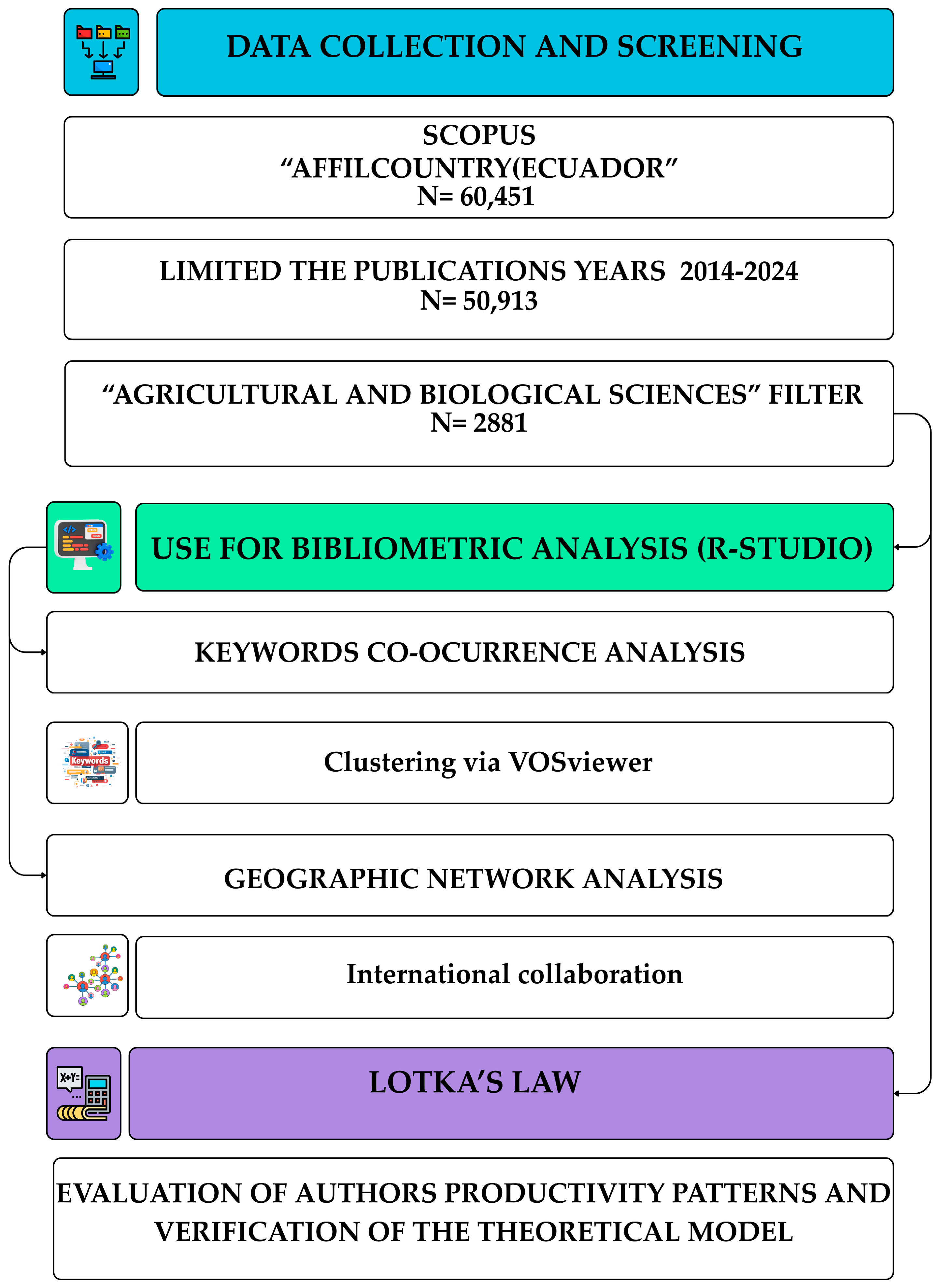
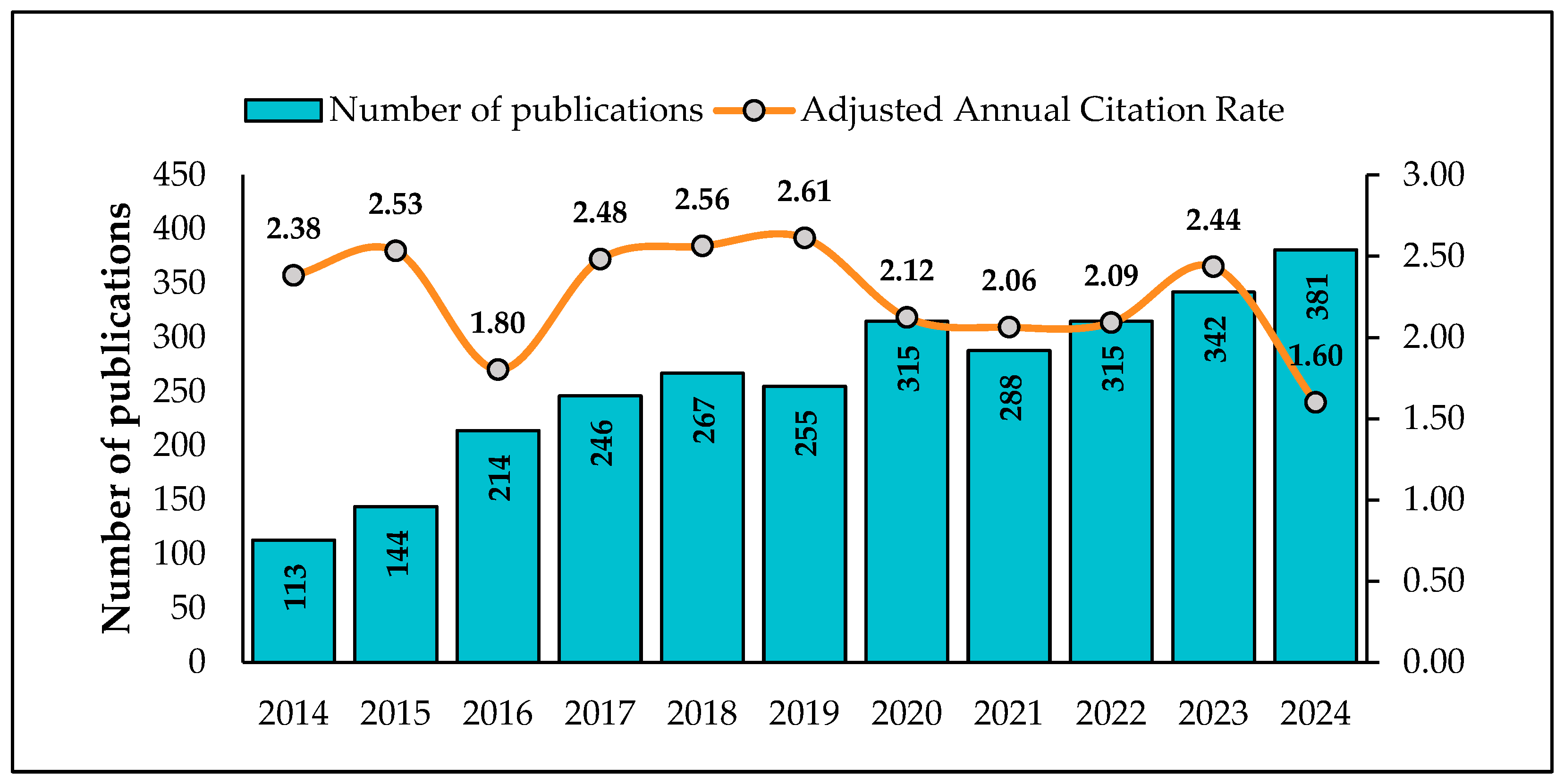
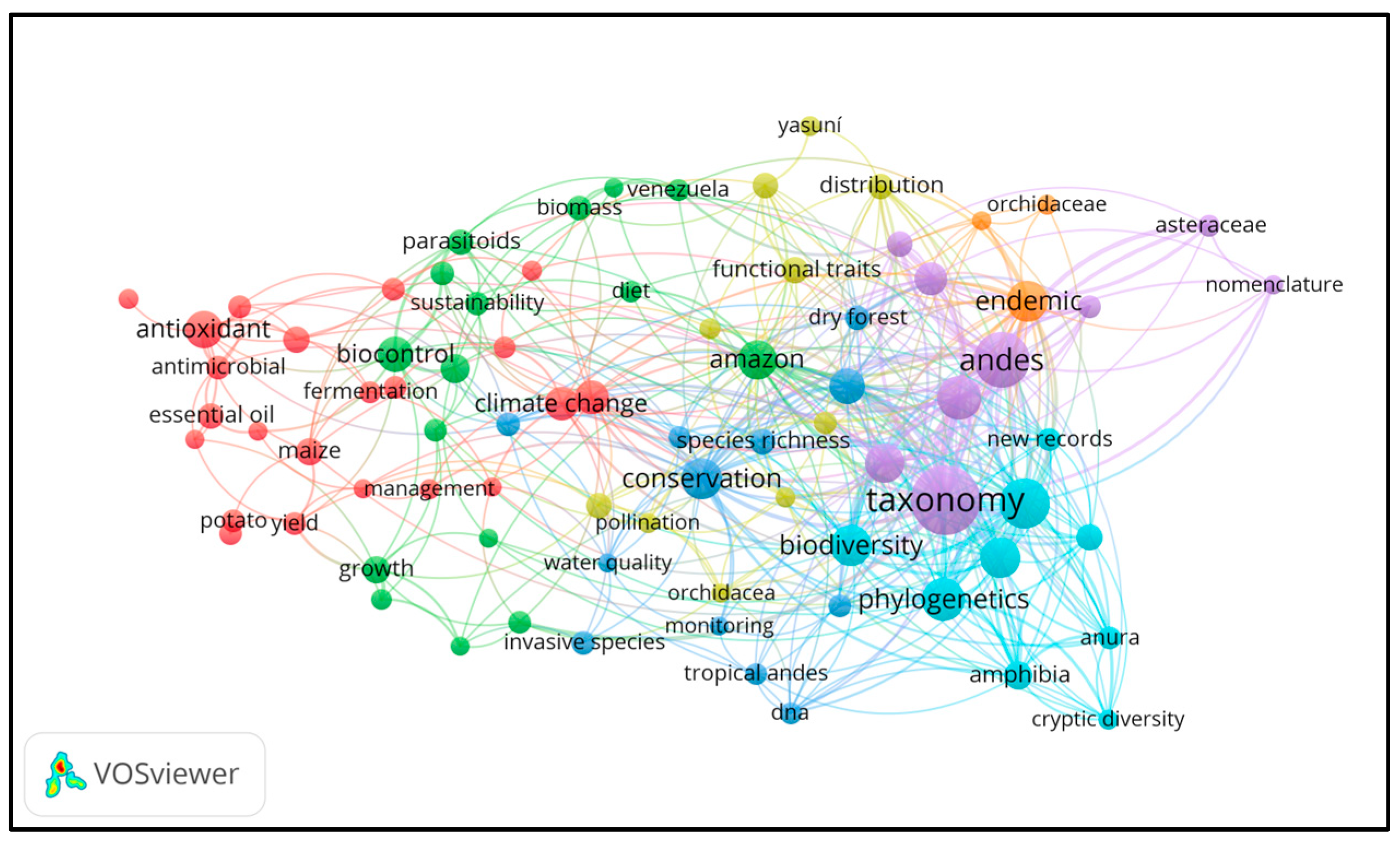
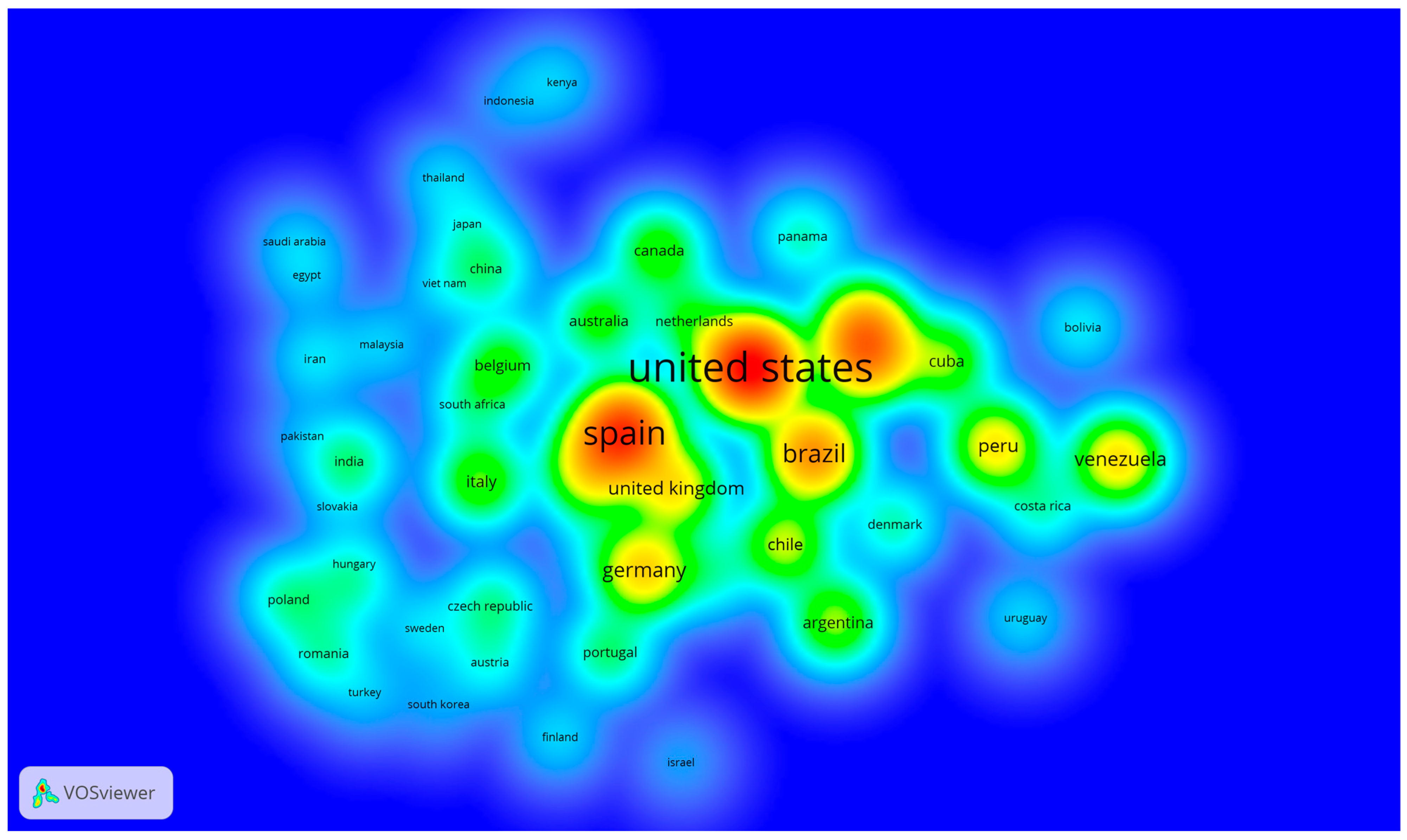

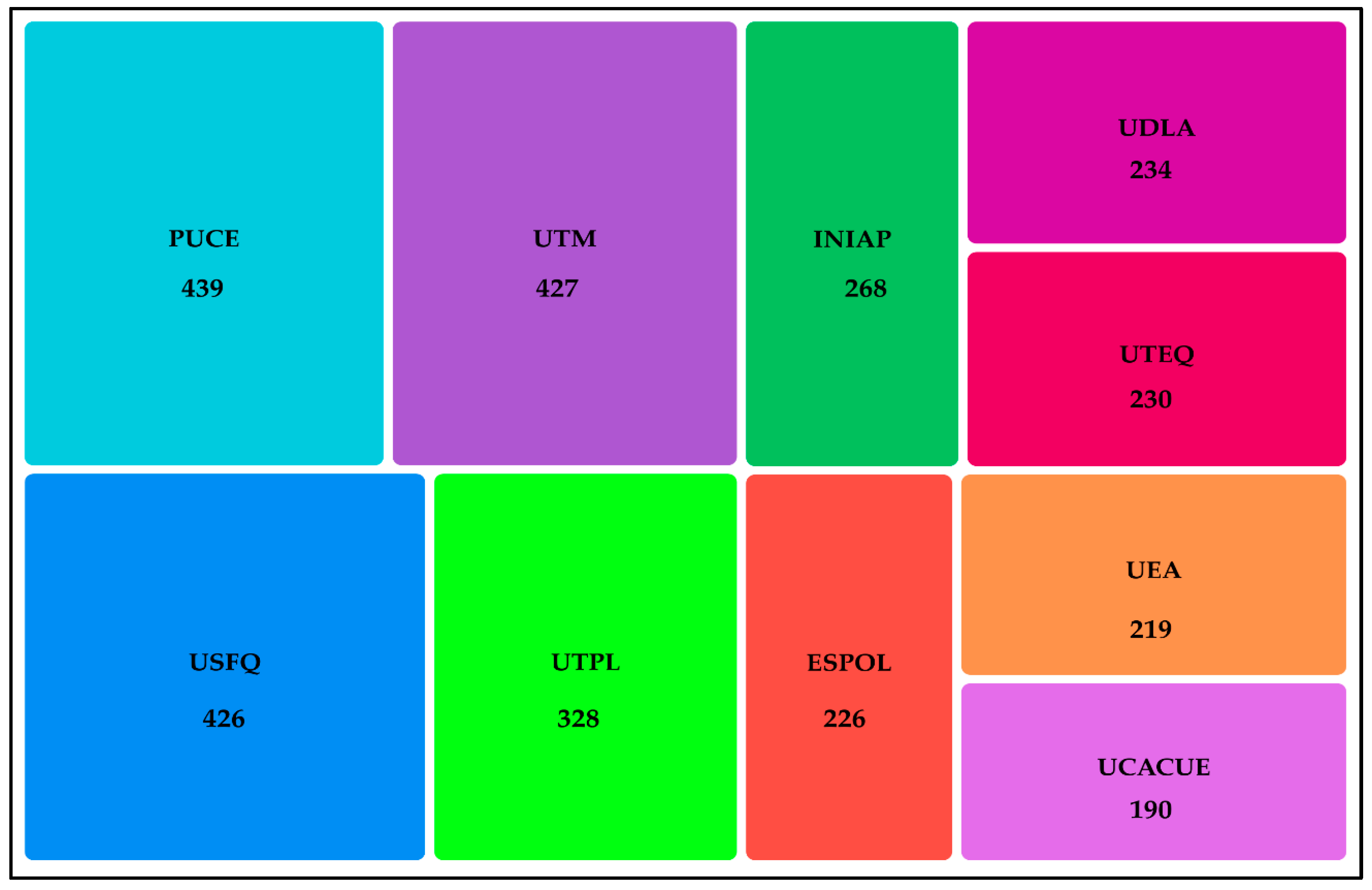
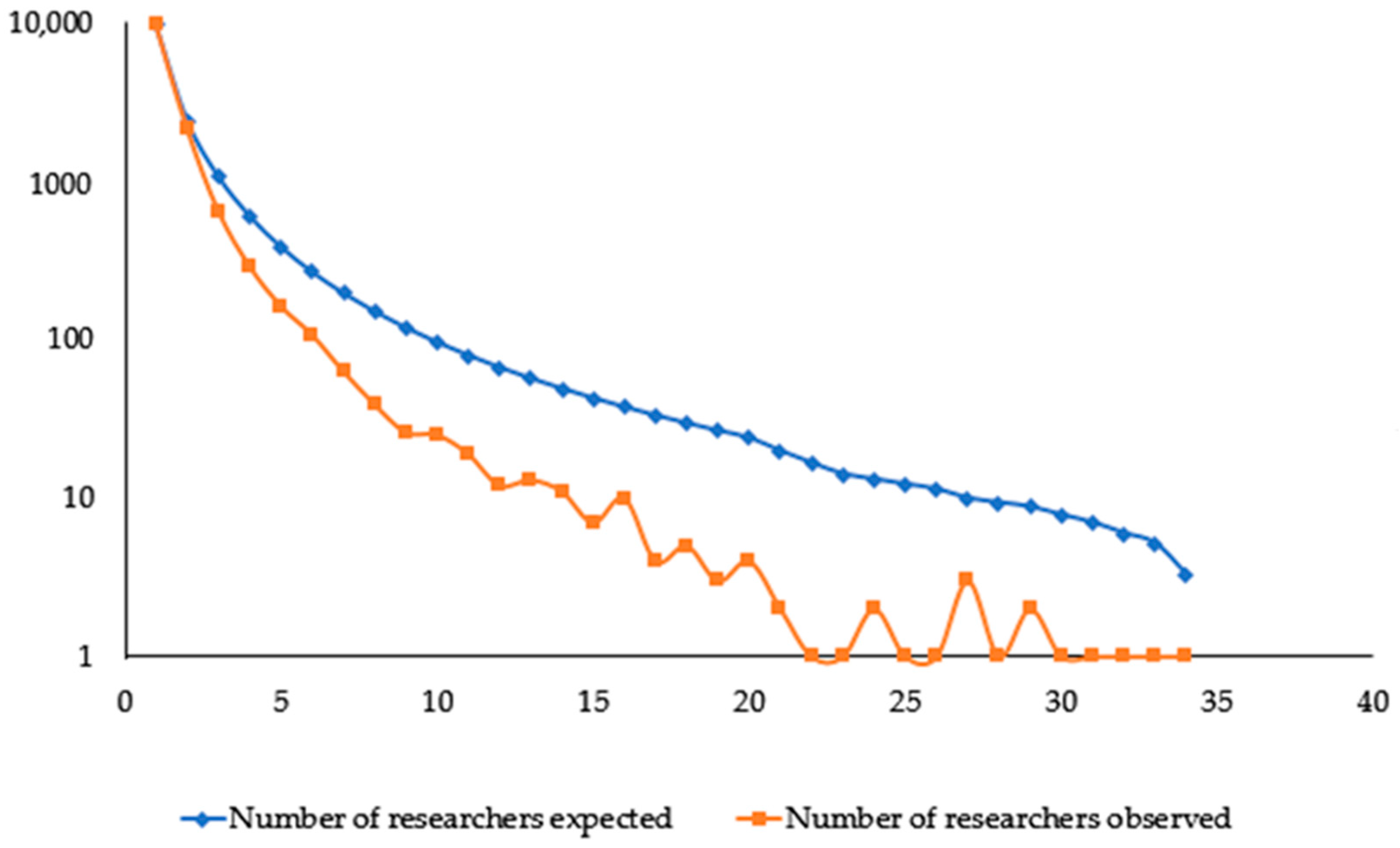
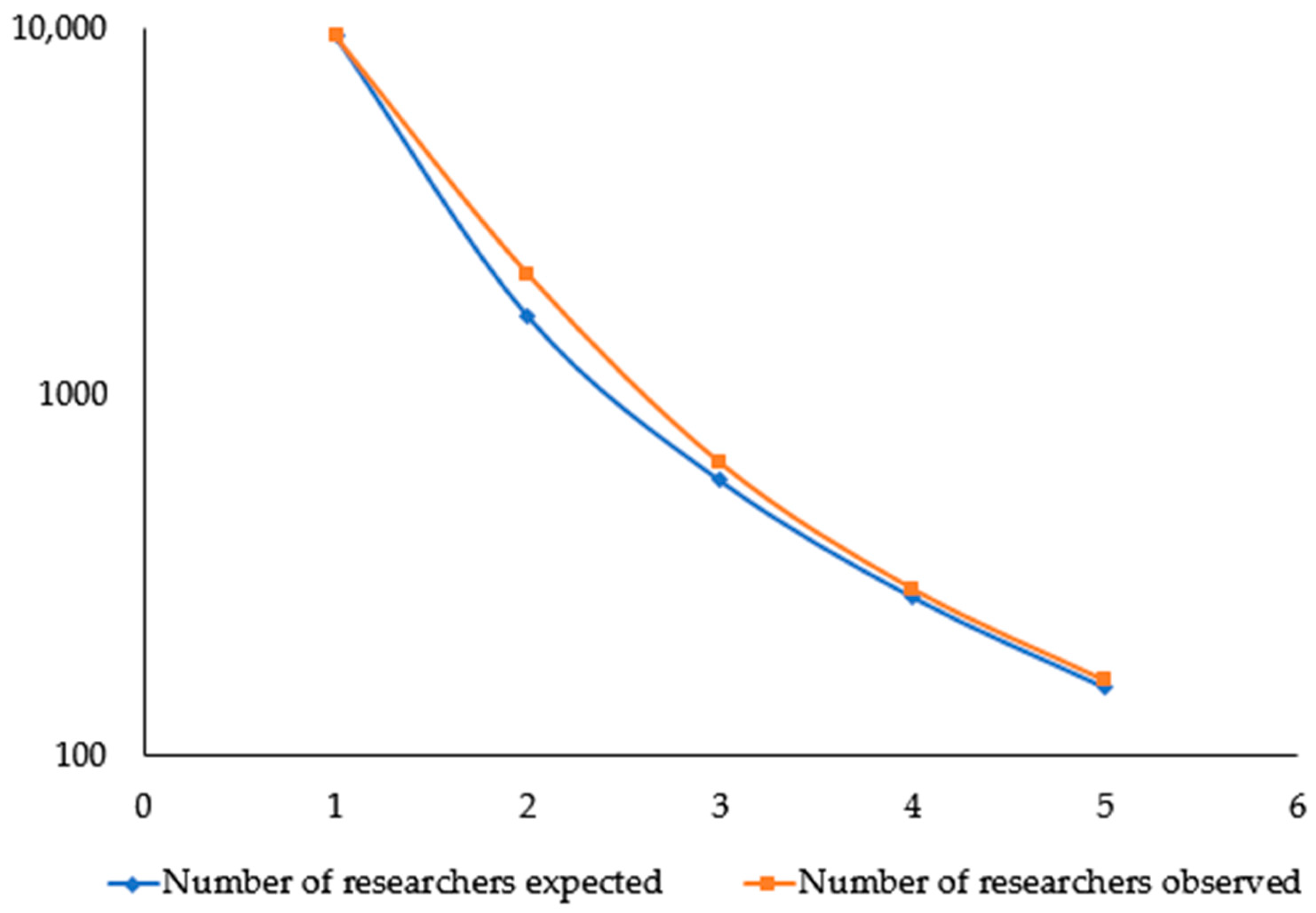
| Journal | Editorial | Number of Articles | Percentage of Total | Country | Impact Factor | SJR 2024 | h-Index | Citations |
|---|---|---|---|---|---|---|---|---|
| Zootaxa | Magnolia Press | 100 | 3.47% | New Zealand | 0.94 | 0.480 (Q2) | 110 | 1368 |
| Agronomy | Multidisciplinary Digital Publishing Institute (MDPI) | 60 | 2.08% | Switzerland | 3.93 | 0.744 (Q1) | 114 | 740 |
| Phytotaxa | Magnolia Press | 100 | 3.47% | New Zealand | 0.96 | 0.337 (Q3) | 54 | 514 |
| Revista de Biología Tropical | Universidad de Costa Rica | 43 | 1.49% | Costa Rica | 0.63 | 0.278 (Q2) | 50 | 357 |
| Revista de la Facultad de Agronomía | Universidad de Zulia | 79 | 2.74% | Venezuela | 0.25 | 0.13 (Q4) | 10 | 82 |
| Frontiers in Plant Science | Frontiers Media S.A. | 41 | 1.42% | Switzerland | 4.85 | 1.163 (Q1) | 216 | 667 |
| Scientia Agropecuaria | Universidad Nacional de Trujillo | 39 | 1.35% | Peru | 1.32 | 0.273 (Q3) | 12 | 128 |
| Forests | Multidisciplinary Digital Publishing Institute (MDPI) | 38 | 1.32% | Switzerland | 2.79 | 0.600 (Q1) | 84 | 375 |
| Name of Institution | Author with the Most Citations | Articles by Author | h Index | First Author | Last Author | Co-Author | Single Author | International Collaboration (%) | Articles in Top Citation Percentiles | Articles in Top 25% Journals | Field-Weighted Citation Impact |
|---|---|---|---|---|---|---|---|---|---|---|---|
| Universidad de Guayaquil | Xavier Cornejo | 54 | 12 | 35% | 16% | 33% | 16% | 75,4% | 9.8% | 8.3% | 2.92 |
| Universidad de las Américas | Luis Baquero | 43 | 7 | 24% | 39% | 33% | 4% | 63.5% | 3.8% | 5.8% | 0.43 |
| Pontificia Universidad Católica del Ecuador | Santiago Ron | 40 | 33 | 7% | 37% | 56% | 0% | 86.6% | 48.8% | 41.5% | 1.78 |
| Universidad Técnica Particular de Loja | Felipe Garcés | 37 | 11 | 15% | 64% | 21% | 0% | 54.5% | 18.2% | 30.2% | 0.59 |
| Universidad Técnica de Manabí | César Lodeiros | 35 | 24 | 24% | 45% | 29% | 2% | 89.2% | 13.8% | 28.1% | 0.48 |
| Pontificia Universidad Católica del Ecuador | Álvaro Pérez | 33 | 11 | 18% | 34% | 48% | 0% | 95.5% | 11.4% | 14.6% | 0.66 |
| Pontificia Universidad Católica del Ecuador | Omar Torres | 33 | 25 | 27% | 31% | 39% | 3% | 83.1% | 32.4% | 51.2% | 1.87 |
| Instituto Nacional de Investigaciones Agropecuarias | William Viera-Arroyo | 32 | 11 | 29% | 31% | 40% | 0% | 32.4% | 14.7% | 19.4% | 0.67 |
| Escuela Superior Politécnica del Litoral | Stanislaus Sonnenholzner | 31 | 15 | 0% | 50% | 50% | 0% | 65.0% | 25.0% | 50.0% | 0.84 |
| Universidad Técnica Estatal de Quevedo | Juan Reyes | 31 | 11 | 39% | 6% | 55% | 0% | 89.1% | 14.1% | 4.4% | 0.66 |
| Average | 37.6 | 16.1 | 24% | 34% | 39% | 3% | 80.21% | 18.56% | 22.61% | 1.12 | |
| Number of Publications (x) | Number of Researchers Observed (y) | Cumulative Number of Researchers Observed | Relative Cumulative Number of Researchers Observed s(x) | Number of Researchers Expected C/X | Cumulative Number of Researchers Expected | Relative Cumulative Number of Researchers Expected f(x) | f(x) − s(x) | |f(x) − s(x)| |
|---|---|---|---|---|---|---|---|---|
| 1 | 9532 | 9532 | 0.7274 | 9532 | 9532 | 0.6206 | −0.1068 | 0.107 |
| 2 | 2113 | 11,645 | 0.8887 | 2383 | 11,915 | 0.7758 | −0.1129 | 0.113 |
| 3 | 641 | 12,286 | 0.9376 | 1059 | 12,974 | 0.8447 | −0.0928 | 0.093 |
| 4 | 289 | 12,575 | 0.9596 | 596 | 13,570 | 0.8835 | −0.0761 | 0.076 |
| 5 | 162 | 12,737 | 0.9720 | 381 | 13,951 | 0.9084 | −0.0636 | 0.064 |
| 6 | 107 | 12,844 | 0.9802 | 265 | 14,216 | 0.9256 | −0.0546 | 0.055 |
| 7 | 63 | 12,907 | 0.9850 | 195 | 14,410 | 0.9383 | −0.0467 | 0.047 |
| 8 | 39 | 12,946 | 0.9879 | 149 | 14,559 | 0.9480 | −0.0400 | 0.040 |
| 9 | 26 | 12,972 | 0.9899 | 118 | 14,677 | 0.9556 | −0.0343 | 0.034 |
| 10 | 25 | 12,997 | 0.9918 | 95 | 14,772 | 0.9618 | −0.0300 | 0.030 |
| 11 | 19 | 13,016 | 0.9933 | 79 | 14,851 | 0.9670 | −0.0263 | 0.026 |
| 12 | 12 | 13,028 | 0.9942 | 66 | 14,917 | 0.9713 | −0.0229 | 0.023 |
| 13 | 13 | 13,041 | 0.9952 | 56 | 14,974 | 0.9749 | −0.0203 | 0.020 |
| 14 | 11 | 13,052 | 0.9960 | 49 | 15,022 | 0.9781 | −0.0179 | 0.018 |
| 15 | 7 | 13,059 | 0.9966 | 42 | 15,065 | 0.9809 | −0.0157 | 0.016 |
| 16 | 10 | 13,069 | 0.9973 | 37 | 15,102 | 0.9833 | −0.0140 | 0.014 |
| 17 | 4 | 13,073 | 0.9976 | 33 | 15,135 | 0.9854 | −0.0122 | 0.012 |
| 18 | 5 | 13,078 | 0.9980 | 29 | 15,164 | 0.9874 | −0.0107 | 0.011 |
| 19 | 3 | 13,081 | 0.9982 | 26 | 15,191 | 0.9891 | −0.0092 | 0.009 |
| 20 | 4 | 13,085 | 0.9986 | 24 | 15,215 | 0.9906 | −0.0079 | 0.008 |
| 22 | 2 | 13,087 | 0.9987 | 20 | 15,234 | 0.9919 | −0.0068 | 0.007 |
| 24 | 1 | 13,088 | 0.9988 | 17 | 15,251 | 0.9930 | −0.0058 | 0.006 |
| 26 | 1 | 13,089 | 0.9989 | 14 | 15,265 | 0.9939 | −0.0050 | 0.005 |
| 27 | 2 | 13,091 | 0.9990 | 13 | 15,278 | 0.9948 | −0.0043 | 0.004 |
| 28 | 1 | 13,092 | 0.9991 | 12 | 15,290 | 0.9955 | −0.0035 | 0.004 |
| 29 | 1 | 13,093 | 0.9992 | 11 | 15,302 | 0.9963 | −0.0029 | 0.003 |
| 31 | 3 | 13,096 | 0.9994 | 10 | 15,311 | 0.9969 | −0.0025 | 0.002 |
| 32 | 1 | 13,097 | 0.9995 | 9 | 15,321 | 0.9975 | −0.0019 | 0.002 |
| 33 | 2 | 13,099 | 0.9996 | 9 | 15,330 | 0.9981 | −0.0015 | 0.002 |
| 35 | 1 | 13,100 | 0.9997 | 8 | 15,337 | 0.9986 | −0.0011 | 0.001 |
| 37 | 1 | 13,101 | 0.9998 | 7 | 15,344 | 0.9991 | −0.0007 | 0.001 |
| 40 | 1 | 13,102 | 0.9998 | 6 | 15,350 | 0.9995 | −0.0004 | 0.000 |
| 43 | 1 | 13,103 | 0.9999 | 5 | 15,355 | 0.9998 | −0.0001 | 0.000 |
| 54 | 1 | 13,104 | 1.0000 | 3 | 15,359 | 1.0000 | 0.0000 | 0.000 |
| Observed Distribution | Expected Distribution According to Lotka’s Law | Goodness-of-Fit Test According to K-S | ||||||
|---|---|---|---|---|---|---|---|---|
| Number of Publications (x) | Number of Researchers Observed (y) | Cumulative Number of Researchers Observed | Relative Cumulative Number of Researchers Observed s(x) | Number of Researchers Expected C/X | Cumulative Number of Researchers Expected | Relative Cumulative Number of Researchers Expected f(x) | f(x) − s(x) | |f(x) − s(x)| |
| 1 | 9532 | 9532 | 0.748 | 9532 | 9532 | 0.785 | 0.0364 | 0.0364 |
| 2 | 2113 | 11,645 | 0.914 | 1615 | 11,147 | 0.918 | 0.0035 | 0.0035 |
| 3 | 641 | 12,286 | 0.965 | 571 | 11,718 | 0.965 | 0.0002 | 0.0002 |
| 4 | 289 | 12,575 | 0.987 | 273 | 11,992 | 0.987 | 0.0000 | 0.0000 |
| 5 | 162 | 12,737 | 1.000 | 154 | 12,146 | 1.000 | 0.0000 | 0.0000 |
| Institution | Value of the n-Parameter | Value of the k-Constant (Percentage of Authors Publishing Only 1 Article) |
|---|---|---|
| Range for the n-parameter (2.00–2.50) | 2.31 | 74.72 |
| UEA | 2.18 | 76.38 |
| ESPOL | 2.44 | 73.07 |
| Range for the n-parameter (2.51–3.00) | 2.79 | 76.33 |
| UTPL | 2.55 | 67.23 |
| UDLA | 2.59 | 67.08 |
| UTEQ | 2.82 | 75.22 |
| UG | 2.82 | 84.33 |
| PUCE | 2.89 | 83.34 |
| UTM | 2.92 | 78.19 |
| INIAP | 2.95 | 78.93 |
| Range for the n-parameter (3.01–3.50) | 3.29 | 87.06 |
| USFQ | 3.10 | 85.69 |
| UCE | 3.48 | 88.42 |
| Average of all institutions | 2.80 | 79.37 |
| Indicator | This Study | Herrera-Franco et al. (2021) | Avello-Martínez et al. (2024) | Herrera-Franco et al. (2023) | Flores & Echeverría (2025) |
|---|---|---|---|---|---|
| Country/Region | Ecuador | Ecuador | Ecuador | Ecuador | Central America |
| Database | Scopus | Scopus and Web of Science | Scielo | Scopus | Scopus |
| Area | Agricultural and Biological Sciences | Agriculture | Multiple areas | Multiple areas | Multiple areas |
| Scientific production (Average annual growth rate) | 12.92% | 45.77% | 58.74% | 18.59% | 23.0% |
| Top 5 countries of international collaboration | United States, Spain, Mexico, Brazil, Germany | United States, Spain, France, Brazil, Belgium | Brazil, Colombia, Chile, Peru, Cuba | Spain, United States, Brazil, Colombia, United Kingdom | United States, Germany, United Kingdom, Switzerland, South Korea |
| Top 5 keywords | Taxonomy, Neotropics, Andes, Diversity, Endemism | Andes, Taxonomy, Antioxidant, Amazon, Genetic diversity | – | Andes, Taxonomy, South America, Galápagos, Conservation | – |
| Top journals | Zootaxa, Agronomy, Phytotaxa, Revista de Biología Tropical, Frontiers in Plant Science | Granja—Revista de Ciencias de la Vida, Food Chemistry, PLOS One, Food Science and Technology, Plants | – | Risti—Revista Ibérica de Sistemas e Tecnologias de Informação, Espacios, Physical Review Letters, PLOS One, Physical Review | Revista de Biología Tropical, PLOS One, Zootaxa, Scientific Reports, American Journal of Tropical Medicine and Hygiene |
Disclaimer/Publisher’s Note: The statements, opinions and data contained in all publications are solely those of the individual author(s) and contributor(s) and not of MDPI and/or the editor(s). MDPI and/or the editor(s) disclaim responsibility for any injury to people or property resulting from any ideas, methods, instructions or products referred to in the content. |
© 2025 by the authors. Licensee MDPI, Basel, Switzerland. This article is an open access article distributed under the terms and conditions of the Creative Commons Attribution (CC BY) license (https://creativecommons.org/licenses/by/4.0/).
Share and Cite
Viera-Arroyo, W.; Vera, L.; Moya, M.; López, D.; Vásquez-Castillo, W.; Caicedo, C. An Assessment of Scientific Productivity: Review in the Area of Agricultural and Biological Sciences in Ecuador Using Scientometrics and Lotka’s Law. Publications 2025, 13, 59. https://doi.org/10.3390/publications13040059
Viera-Arroyo W, Vera L, Moya M, López D, Vásquez-Castillo W, Caicedo C. An Assessment of Scientific Productivity: Review in the Area of Agricultural and Biological Sciences in Ecuador Using Scientometrics and Lotka’s Law. Publications. 2025; 13(4):59. https://doi.org/10.3390/publications13040059
Chicago/Turabian StyleViera-Arroyo, William, Lya Vera, Martín Moya, Duther López, Wilson Vásquez-Castillo, and Carlos Caicedo. 2025. "An Assessment of Scientific Productivity: Review in the Area of Agricultural and Biological Sciences in Ecuador Using Scientometrics and Lotka’s Law" Publications 13, no. 4: 59. https://doi.org/10.3390/publications13040059
APA StyleViera-Arroyo, W., Vera, L., Moya, M., López, D., Vásquez-Castillo, W., & Caicedo, C. (2025). An Assessment of Scientific Productivity: Review in the Area of Agricultural and Biological Sciences in Ecuador Using Scientometrics and Lotka’s Law. Publications, 13(4), 59. https://doi.org/10.3390/publications13040059







